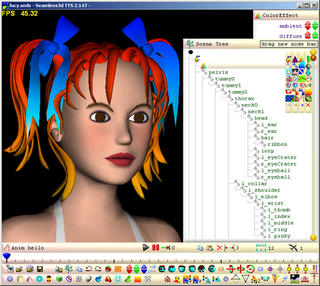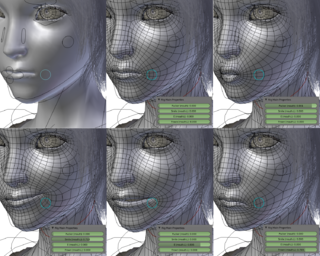
Computer animation is the process used for digitally generating moving images. The more general term computer-generated imagery (CGI) encompasses both still images and moving images, while computer animation only refers to moving images. Modern computer animation usually uses 3D computer graphics.
Autodesk 3ds Max, formerly 3D Studio and 3D Studio Max, is a professional 3D computer graphics program for making 3D animations, models, games and images. It is developed and produced by Autodesk Media and Entertainment. It has modeling capabilities and a flexible plugin architecture and must be used on the Microsoft Windows platform. It is frequently used by video game developers, many TV commercial studios, and architectural visualization studios. It is also used for movie effects and movie pre-visualization. 3ds Max features shaders, dynamic simulation, particle systems, radiosity, normal map creation and rendering, global illumination, a customizable user interface, and its own scripting language.
Visual effects is the process by which imagery is created or manipulated outside the context of a live-action shot in filmmaking and video production. The integration of live-action footage and other live-action footage or CGI elements to create realistic imagery is called VFX.
Animation:Master is a 3D character animation application offered by Hash, Inc. that includes tools for modeling, rigging, animating, texturing, lighting and rendering. Although Animation:Master was developed for and is targeted towards independent artists, with a workflow optimized to enable one artist to create a rendered animated piece from start to finish, the workflow also presents economic advantages for larger workgroups.

Ragdoll physics is a type of procedural animation used by physics engines, which is often used as a replacement for traditional static death animations in video games and animated films. As computers increased in power, it became possible to do limited real-time physical simulations, which made death animations more realistic.

In 3D computer graphics and solid modeling, a polygon mesh is a collection of vertices, edges and faces that defines the shape of a polyhedral object. The faces usually consist of triangles, quadrilaterals (quads), or other simple convex polygons (n-gons), since this simplifies rendering, but may also be more generally composed of concave polygons, or even polygons with holes.

In 3D computer graphics, polygonal modeling is an approach for modeling objects by representing or approximating their surfaces using polygon meshes. Polygonal modeling is well suited to scanline rendering and is therefore the method of choice for real-time computer graphics. Alternate methods of representing 3D objects include NURBS surfaces, subdivision surfaces, and equation-based representations used in ray tracers.
Computer facial animation is primarily an area of computer graphics that encapsulates methods and techniques for generating and animating images or models of a character face. The character can be a human, a humanoid, an animal, a legendary creature or character, etc. Due to its subject and output type, it is also related to many other scientific and artistic fields from psychology to traditional animation. The importance of human faces in verbal and non-verbal communication and advances in computer graphics hardware and software have caused considerable scientific, technological, and artistic interests in computer facial animation.
Interactive skeleton-driven simulation is a scientific computer simulation technique used to approximate realistic physical deformations of dynamic bodies in real-time. It involves using elastic dynamics and mathematical optimizations to decide the body-shapes during motion and interaction with forces. It has various applications within realistic simulations for medicine, 3D computer animation and virtual reality.

Softimage|3D is a discontinued high-end 3D graphics application developed by Softimage, Co., which was used predominantly in the film, broadcasting, gaming, and advertising industries for the production of 3D animation. It was superseded by Softimage XSI in 2000.

Seamless3d is an open-source 3D modeling software available under the MIT license.
Messiah is a 3D animation and rendering application developed by pmG Worldwide. It runs on the Win32 and Win64 platforms. It is marketed to run on Mac OS X and Linux via Wine. Messiah's fourth version, messiah:studio was released April 2009 and version 5.5b as messiah:animate was released November 2006. messiahStudio6 was released in April 2013. Messiah seems no longer maintained since 2013 (abandoned).

A vertex in computer graphics is a data structure that describes certain attributes, like the position of a point in 2D or 3D space, or multiple points on a surface.
Pose space deformation is a computer animation technique which is used to deform a mesh on skeleton-driven animation. Common use of this technique is to deform the shape of a mesh according to the angle of the joint bent. Although the name is commonly called Pose space deformation on many scholarly articles, 3D animation software rarely uses that name. On Autodesk Maya, it's implemented under the name Pose Deformer, and on Blender, it's implemented as Corrective Shape Keys. The first famous application of this technique was the cloth's movement on the first episode of the animated film The Animatrix.

Morph target animation, per-vertex animation, shape interpolation, shape keys, or blend shapes is a method of 3D computer animation used together with techniques such as skeletal animation. In a morph target animation, a "deformed" version of a mesh is stored as a series of vertex positions. In each key frame of an animation, the vertices are then interpolated between these stored positions.

Nadia Magnenat Thalmann is a computer graphics scientist and robotician and is the founder and head of MIRALab at the University of Geneva. She has chaired the Institute for Media Innovation at Nanyang Technological University (NTU), Singapore from 2009 to 2021.
Rendez-vous in Montreal is a 1987 animated film that used advanced computer techniques to achieve such effects as modelling the film stars Marilyn Monroe and Humphrey Bogart. The film was directed by Nadia Magnenat Thalmann and Daniel Thalmann and produced with a team of 10 people. Specific interactive software [1] was developed that allowed designers to interactively use commands to generate the sequences. The main purpose of Rendez-vous in Montreal was to show that true synthetic actors can be created. This film represented a technological breakthrough both on the software side and the film itself.
This is a glossary of terms relating to computer graphics.

In 3D computer graphics software, vertex painting refers to interactive editing tools for modifying vertex attributes directly on a 3D polygon mesh, using painting tools similar to any digital painting application but working in a 3D viewport on a perspective view of a rotated model. It is similar to a 3D paint tool but operates specifically to vertex data rather than texture maps.

A virtual human is a software fictional character or human being. Virtual human have been created as tools and artificial companions in simulation, video games, film production, human factors and ergonomic and usability studies in various industries, clothing industry, telecommunications (avatars), medicine, etc. These applications require domain-dependent simulation fidelity. A medical application might require an exact simulation of specific internal organs; film industry requires highest aesthetic standards, natural movements, and facial expressions; ergonomic studies require faithful body proportions for a particular population segment and realistic locomotion with constraints, etc.









